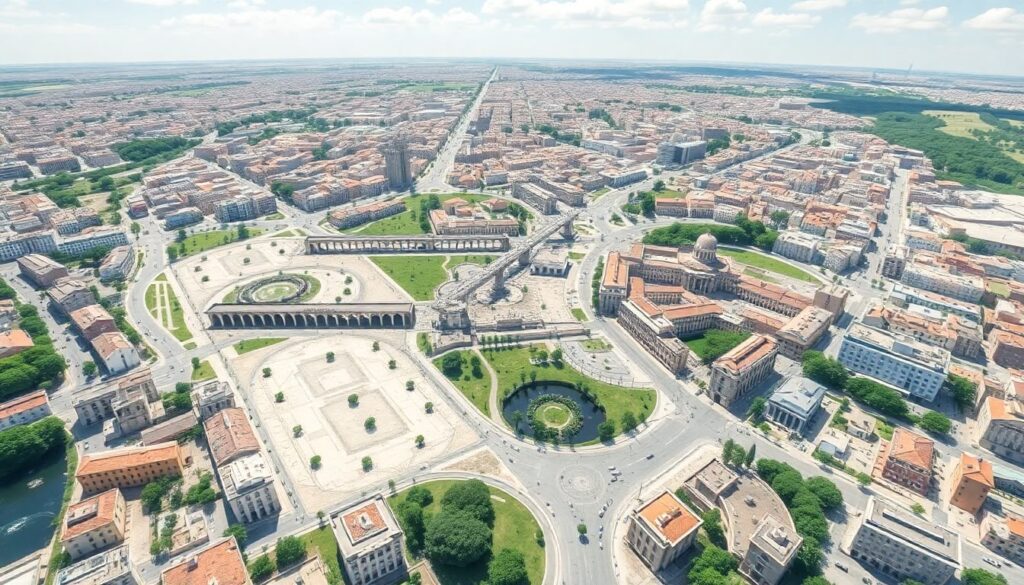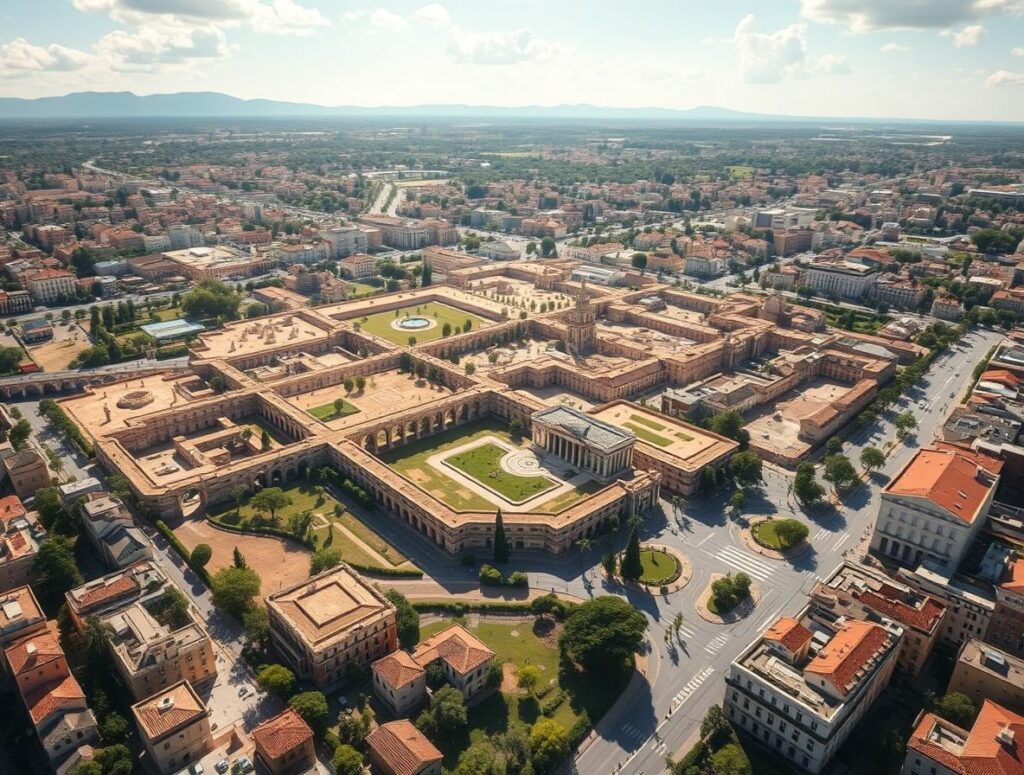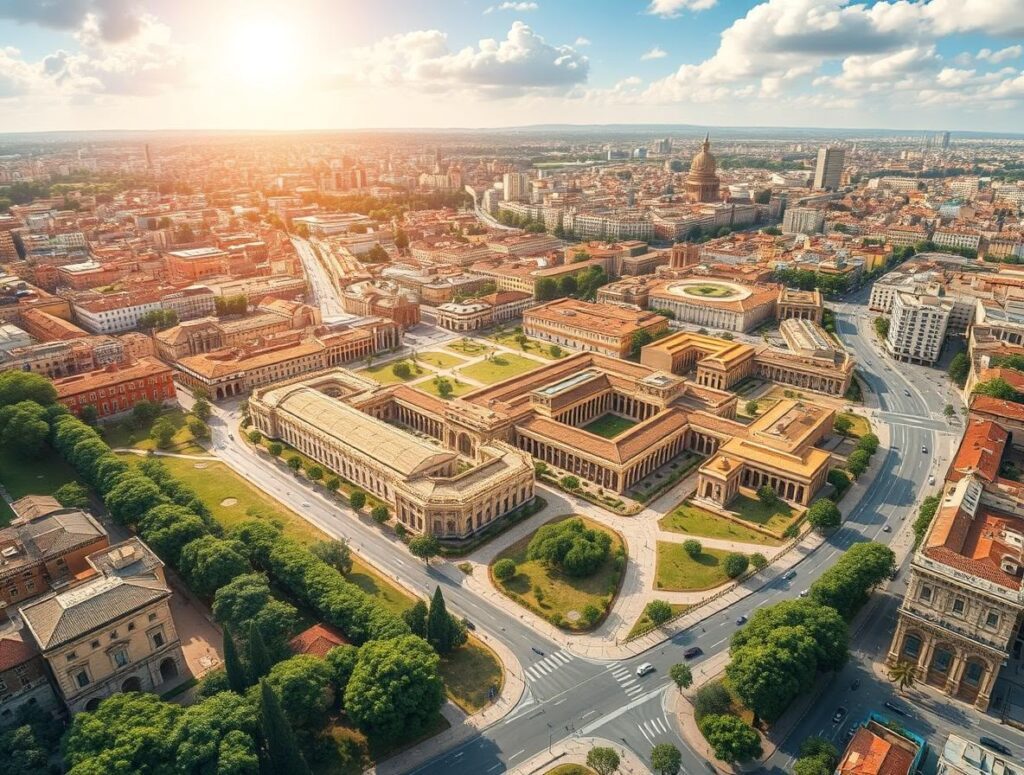The urban planner’s desk overflows with impossibilities. Rising populations. Crumbling infrastructure. Climate change threats. Budget constraints. Political pressures. The modern city builder faces a perfect storm of challenges that would make even the most seasoned professional question whether sustainable, functional urban environments are possible anymore.
Yet the solutions to our most pressing infrastructure problems may be hiding in plain sight – or rather, beneath our feet, in the remnants of a civilization that mastered urban planning two millennia ago.
While we marvel at the latest smart city innovations and debate the merits of various urban planning theories, the ghosts of Roman engineers watch with knowing smiles. They solved many of these same problems long before computer modeling, environmental impact studies, or traffic flow simulations existed.
What if the most innovative solutions to our urban challenges aren’t new at all? What if they’ve been tested and proven over thousands of years?
The Timeless Challenge of Urban Infrastructure
Urban planners today face a seemingly impossible task. They must create environments that accommodate growing populations, withstand increasing climate threats, support economic growth, promote public health, and do it all within shrinking budgets. The complexity is staggering.
Consider the water infrastructure crisis facing many American cities. Aging pipes, some over a century old, leak trillions of gallons of water annually. Meanwhile, climate change brings unprecedented drought to some regions and flooding to others. Our water systems, designed for a different era, struggle to adapt.
Or examine our road networks, perpetually congested despite endless expansion projects. The typical urban commuter spends hours each week sitting in traffic, creating economic losses, environmental damage, and public health concerns.
Our challenges feel uniquely modern, but they are, in many ways, universal. Two thousand years ago, Roman urban planners faced remarkably similar problems: how to house growing populations, provide clean water, manage waste, facilitate transportation, and create public spaces that fostered community well-being.
The difference? They solved these problems with solutions so fundamentally sound that many continue to function today.
The Roman Infrastructure Mindset: Building for Millennia, Not Decades
The Roman approach to infrastructure differed fundamentally from our modern methodology in one crucial aspect: time horizon. While contemporary projects typically plan for 50-100 year lifespans (often with far shorter actual results), Roman engineers designed for eternity.
This perspective shift changes everything. When you build for millennia rather than decades, you make profoundly different decisions about materials, design redundancies, maintenance requirements, and adaptability.
Imagine if modern infrastructure planners approached each project with the question: “How will this function 2,000 years from now?” The entire calculus of urban development would transform. Initial costs might increase, but the long-term economics would become dramatically more favorable.
The Roman mindset wasn’t just about durability. It centered on several key principles that modern planners would be wise to reconsider:
1. Standardization with Local Adaptation
Romans created standardized urban templates that could be efficiently implemented across their vast empire, yet they wisely allowed for local adaptation based on terrain, climate, and cultural factors. This balance between standardization and customization represents the holy grail of efficient urban planning.
The Roman grid system – the orthogonal arrangement of streets intersecting at right angles – became the template for cities throughout the empire. This standardized approach allowed for rapid urban development while creating logical navigation systems. Yet Roman engineers weren’t rigid ideologues; they modified the perfect grid when local topography demanded it.
In hilly regions like parts of modern Portugal and Spain, Romans adapted their city plans to work with the natural landscape rather than imposing the ideal form regardless of terrain. This pragmatic flexibility stands in stark contrast to many modern developments that bulldoze natural features to impose standardized designs.
2. Infrastructure as Public Good
Romans viewed infrastructure as a public responsibility and a reflection of societal values. Aqueducts, public baths, forums, and roads weren’t luxuries or profit centers – they were essential public goods that demonstrated Roman greatness while serving practical needs.
This perspective contrasts sharply with our modern tendency to privatize infrastructure or treat it as a necessary but unexciting budget line item. Romans understood that infrastructure shapes civilization itself. The quality of public works reflected the empire’s strength and stability.
Walking through the Roman Forum or standing beneath a towering aqueduct, citizens experienced daily reminders of collective achievement and societal capability. Infrastructure wasn’t hidden away – it was celebrated as a visible manifestation of Roman ingenuity and power.
3. Systems Thinking Before Systems Engineering
Long before formal systems engineering existed as a discipline, Romans practiced integrated infrastructure planning. Their urban developments considered water, waste, transportation, public space, and housing as interconnected systems rather than isolated projects.
This holistic approach prevented the siloed thinking that plagues many modern urban developments, where highway departments, water authorities, and housing agencies often work in isolation from one another. Roman urban planning integrated these functions by necessity and design.
The result was urban environments where different systems complemented rather than competed with each other. Water management connected to public health through the bath system. Transportation networks integrated with commercial needs through strategically placed forums and markets.

The Aqueduct Principle: Gravity-Powered Resilience
Perhaps no Roman achievement better exemplifies their infrastructure genius than the aqueduct system. While we marvel at the soaring arches that carried water across valleys, the true brilliance lies in the system’s fundamental design principles.
Roman aqueducts transported water vast distances using nothing but gravity – no pumps, no electricity, no fossil fuels. The entire system operated on a precise gradient of just 1:4,800 (a drop of one foot over 4,800 feet of distance), requiring extraordinary precision in surveying and construction.
This design choice created remarkable resilience. Without mechanical components to fail or energy inputs to disrupt, aqueducts could continue functioning through political upheaval, economic collapse, and even the fall of the empire itself. Some Roman aqueducts continued supplying water for nearly 1,500 years after construction.
The aqueduct principle – designing systems that work with natural forces rather than against them – offers a powerful lesson for contemporary infrastructure. Our complex, energy-intensive systems often prove fragile precisely because of their complexity and dependency on constant inputs.
Modern water systems rely on elaborate treatment plants, powerful pumps, and extensive monitoring technology – all vulnerable to power outages, supply chain disruptions, cyberattacks, and technical failures. While offering greater capacity and treatment capability, these systems sacrifice the fundamental resilience that characterized Roman designs.
What might our infrastructure look like if we rediscovered the aqueduct principle? We might develop more gravity-fed systems, passive heating and cooling designs, and naturally ventilated buildings. We might prioritize mechanical simplicity and redundancy over maximum efficiency.
The Grid System: Flexibility Within Structure
The Roman urban grid represents another enduring infrastructure innovation. Cities like Turin, Florence, Barcelona, and countless others still follow street patterns established during Roman times. Even London’s financial district and parts of Paris reveal the ghostly outlines of their Roman origins.
The genius of the Roman grid wasn’t just its navigational clarity but its adaptive capacity. Within the organized framework of perpendicular streets, Romans created a hierarchy of thoroughfares and diverse neighborhoods. The grid provided structure without imposing monotony.
This balance between order and diversity remains the elusive goal of urban planners today. Too rigid, and cities become sterile and unresponsive to changing needs. Too chaotic, and they become inefficient and disorienting.
Modern cities that thrive often achieve this same balance. Barcelona’s Eixample district, designed by Ildefons Cerdà in the 19th century, built upon Roman planning principles by creating a grid of octagonal blocks with chamfered corners. This adaptation created small plazas at intersections, improved visibility, and enhanced pedestrian movement while maintaining the efficiency of the grid system.
Manhattan’s famous grid system, established in 1811, similarly provides structure while allowing for distinctly different neighborhoods to develop within its framework. The predictable street pattern supports orientation and efficient movement while accommodating remarkable variety in building forms and neighborhood character.

Public Space as Social Infrastructure
Romans understood something many modern planners have forgotten: public spaces aren’t amenities but essential social infrastructure. The Roman forum served as the heart of civic life – combining government functions, commercial activity, religious practice, and social gathering in a single integrated environment.
This multi-functional approach to public space creates resilience and vitality that specialized zones cannot match. When spaces serve multiple purposes throughout the day and across seasons, they remain active and relevant despite changing conditions.
Contemporary urban planning often separates these functions into distinct districts – government centers, shopping malls, entertainment zones – creating areas that become deserted outside their primary use hours. The vibrancy that characterizes great cities emerges from precisely the kind of functional mixing that Romans practiced intuitively.
The most successful modern public spaces recapture this Roman wisdom. New York’s Bryant Park demonstrates how a well-designed public space can serve diverse functions simultaneously – hosting office workers at lunch, families on weekends, cultural events in the evening, and providing a green respite within the urban grid year-round.
The Road Network: Connecting Empire and Economy
The famous saying “all roads lead to Rome” reflects a transportation infrastructure achievement unparalleled until the modern highway system. Roman roads – approximately 250,000 miles of paved highways connecting the empire – weren’t just military corridors but economic lifelines.
What made Roman roads remarkable wasn’t just their extent but their construction. Built with multiple layers – a foundation of rubble and sand, middle layers of gravel or crushed brick, and a surface of fitted stone blocks – these roads were designed to withstand centuries of use in all weather conditions.
The slight crowning of the road surface facilitated drainage, while carefully planned ditches along the sides prevented water damage. This attention to water management – a consistent theme in Roman infrastructure – protected their investment and extended the roads’ functional lifespan immeasurably.
Modern highway engineers still apply these same principles, though often with less durable materials. Our asphalt surfaces, while cheaper and faster to install, require frequent maintenance and reconstruction. The Roman preference for higher initial investment in exchange for dramatically lower lifetime costs represents another principle we would be wise to reconsider.

Water Management: The Foundation of Urban Health
Romans developed the most sophisticated water management systems of the ancient world, creating the foundation for urban public health. Their integrated approach included not just the famous aqueducts but comprehensive systems for distribution, use, and waste removal.
Clean water flowed into cities through aqueducts, was stored in distribution reservoirs, then channeled to public fountains, baths, and some private homes. After use, an extensive sewer system – including the massive Cloaca Maxima in Rome itself – carried wastewater away from population centers.
This systems approach to the complete water cycle – from source to disposal – prevented the water contamination issues that plagued medieval cities after Roman infrastructure fell into disrepair. When European cities finally rediscovered effective sanitation in the 19th century, they essentially reimplemented Roman principles that had been forgotten for centuries.
Today’s water challenges – from ensuring clean drinking water to managing stormwater and preventing flooding – might benefit from revisiting the Roman approach to integrated water management. Their understanding of watershed dynamics, gravity-powered distribution, and the importance of separating clean and waste streams remains relevant despite technological advances.
Modern Applications: Learning Without Copying
The point isn’t to abandon modern technology and return to Roman methods wholesale. Rather, it’s to extract the timeless principles that made Roman infrastructure so remarkably durable and adapt them to contemporary challenges.
Several key lessons stand out for today’s urban planners:
Design for the Very Long Term
The Roman time horizon fundamentally changed their approach to materials, redundancy, and maintenance. While modern budgets may not support building every project to last millennia, extending our planning horizons beyond typical political cycles would transform infrastructure outcomes.
What would change if we designed critical infrastructure to function reliably for 500 years rather than 50? We might select different materials, create more redundant systems, and allocate resources differently between initial construction and ongoing maintenance.
Embrace Simplicity and Passive Systems
Roman infrastructure relied on passive systems working with natural forces – gravity, thermal dynamics, and material properties – rather than complex mechanical solutions requiring constant energy inputs. This approach created inherent resilience.
Modern infrastructure could incorporate more passive elements – gravity-fed water systems where topography permits, passive cooling techniques in buildings, naturally ventilated spaces – reducing vulnerability to power outages and mechanical failures.
Integrate Multiple Functions
Roman public works typically served multiple purposes simultaneously. Aqueducts doubled as bridges. Forums combined government, commerce, and social functions. Roads served military, commercial, and civilian needs.
This multi-functionality created efficiency and resilience. When infrastructure serves diverse purposes, it remains valuable even as specific needs evolve. Modern infrastructure could similarly benefit from intentional layering of functions rather than single-purpose optimization.
Design With Pride and Aspiration
Romans viewed infrastructure as a demonstration of their capabilities and values. Even utilitarian structures received architectural attention and often displayed inscriptions commemorating their creation.
This approach transformed infrastructure from mere technical necessity into cultural expression. Modern societies might similarly benefit from treating infrastructure as worthy of design excellence and public celebration rather than as invisible technical systems to be hidden away.
Toward a New Roman Infrastructure Renaissance
As we face unprecedented infrastructure challenges – adapting to climate change, accommodating growing urban populations, replacing aging systems – the Roman blueprint offers valuable guidance.
The most powerful Roman legacy isn’t specific techniques but their infrastructure philosophy: build for generations not quarters, integrate systems holistically, work with natural forces, design with cultural significance, and create adaptable frameworks that accommodate changing needs while maintaining overall coherence.
Perhaps the greatest Roman infrastructure lesson is the power of ambitious public works to shape civilization itself. Their aqueducts, roads, forums, and buildings didn’t just serve practical needs – they expressed Roman values and ambitions, creating physical manifestations of their societal vision.
Our infrastructure similarly reflects our values, priorities, and collective vision. The choices we make today about what to build, how to build it, and who it serves will shape societies for generations to come.
As we stand at a crucial infrastructure crossroads, facing decisions about how to rebuild and adapt our cities for the coming century, we would be wise to consider the engineers who preceded us by two millennia. Their work remains not just in ruins and museums but in the functioning foundations of our cities and the principles that still govern effective urban design.
The Romans remind us that truly great infrastructure transcends time – not just by physically enduring, but by embodying principles so fundamentally sound that they remain relevant across millennia. Perhaps our greatest infrastructure innovation would be rediscovering this timeless wisdom and applying it to our distinctly modern challenges.
As we imagine never having to worry about infrastructure planning again, we might start by asking: What would the Romans build?

